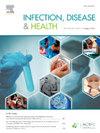Ventilator-associated pneumonia risk factors in patients with severe COVID-19 in southern Brazil: A retrospective observational study
IF 2
Q2 PUBLIC, ENVIRONMENTAL & OCCUPATIONAL HEALTH
引用次数: 0
Abstract
Backgound
During the SARS-CoV-2 pandemic, a significant number of critical patients required ventilatory assistance in health institutions. In this context, Ventilator-Associated Pneumonia (VAP) was the most prevalent nosocomial infection among critically ill patients. We aimed to analyze the occurrence of VAP in critically ill patients with SARS-CoV-2 and the risk factors associated with the outcome.
Method
This is a multicenter, retrospective cohort study which included patients ≥18 years old, diagnosed with COVID-19, admitted to intensive care units (ICU) and who received invasive mechanical ventilation (MV) for >2 consecutive days. The associations between the variables were initially tested, and those that showed potential associations (p<0.05) were included in the multivariate logistic regression model.
Results
One third of patients had an episode of VAP, with an incidence density of 34.97 cases per 1000 MV days. In addition, 42.37% (50) of the microorganisms causing VAP were multidrug-resistant, predominantly gram-negative bacteria (61.32%). More than 50% of participants developed healthcare-associated infections and 243 (73.64%) died. The factors associated with greater chances of VAP were: prone position (OR= 3.77), BMI 25-29.9 kg/m2 (OR= 4.76), pressure injury (OR= 4.41), length of stay in the ICU (OR= 1.06), positive tracheal aspirate before VAP (OR= 5.41) and dyspnea (OR= 3.80).
Conclusions
Patients with COVID-19 are at high risk of VAP, which leads to an increased risk of death (OR = 2.18). Multiple factors increase the chances of VAP in this population, namely: work overload in health institutions, prone position, prolonged ICU time, infusion of multiple drugs, invasive devices, and in particular, immobility in bed.
巴西南部重症 COVID-19 患者的呼吸机相关肺炎风险因素:一项回顾性观察研究。
背景:在 SARS-CoV-2 大流行期间,医疗机构中有大量危重病人需要呼吸机辅助治疗。在这种情况下,呼吸机相关肺炎(VAP)成为危重病人中最常见的院内感染。我们的目的是分析 SARS-CoV-2 重症患者中 VAP 的发生率以及与结果相关的风险因素:这是一项多中心、回顾性队列研究,研究对象包括年龄≥18 岁、确诊感染 COVID-19、入住重症监护病房(ICU)且连续接受有创机械通气(MV)2 天以上的患者。对各变量之间的关联性进行了初步检验,结果表明这些变量之间存在潜在关联(p):三分之一的患者曾发生过 VAP,发病密度为每 1000 个机械通气日 34.97 例。此外,42.37%(50 例)引起 VAP 的微生物具有多重耐药性,主要是革兰氏阴性菌(61.32%)。超过 50%的参与者发生了医护相关感染,243 人(73.64%)死亡。与VAP发生几率较大相关的因素有:俯卧位(OR= 3.77)、体重指数25-29.9 kg/m2(OR= 4.76)、压力损伤(OR= 4.41)、ICU住院时间(OR= 1.06)、VAP前气管吸痰阳性(OR= 5.41)和呼吸困难(OR= 3.80):COVID-19患者发生VAP的风险很高,导致死亡风险增加(OR=2.18)。多种因素增加了这一人群发生 VAP 的几率,即:医疗机构工作负荷过重、俯卧位、重症监护室时间过长、输注多种药物、侵入性设备,尤其是卧床不动。
本文章由计算机程序翻译,如有差异,请以英文原文为准。
求助全文
约1分钟内获得全文
求助全文
来源期刊

Infection Disease & Health
PUBLIC, ENVIRONMENTAL & OCCUPATIONAL HEALTH-
CiteScore
5.70
自引率
5.70%
发文量
40
审稿时长
20 days
期刊介绍:
The journal aims to be a platform for the publication and dissemination of knowledge in the area of infection and disease causing infection in humans. The journal is quarterly and publishes research, reviews, concise communications, commentary and other articles concerned with infection and disease affecting the health of an individual, organisation or population. The original and important articles in the journal investigate, report or discuss infection prevention and control; clinical, social, epidemiological or public health aspects of infectious disease; policy and planning for the control of infections; zoonoses; and vaccination related to disease in human health. Infection, Disease & Health provides a platform for the publication and dissemination of original knowledge at the nexus of the areas infection, Disease and health in a One Health context. One Health recognizes that the health of people is connected to the health of animals and the environment. One Health encourages and advances the collaborative efforts of multiple disciplines-working locally, nationally, and globally-to achieve the best health for people, animals, and our environment. This approach is fundamental because 6 out of every 10 infectious diseases in humans are zoonotic, or spread from animals. We would be expected to report or discuss infection prevention and control; clinical, social, epidemiological or public health aspects of infectious disease; policy and planning for the control of infections; zoonosis; and vaccination related to disease in human health. The Journal seeks to bring together knowledge from all specialties involved in infection research and clinical practice, and present the best work in this ever-changing field. The audience of the journal includes researchers, clinicians, health workers and public policy professionals concerned with infection, disease and health.
 求助内容:
求助内容: 应助结果提醒方式:
应助结果提醒方式:


